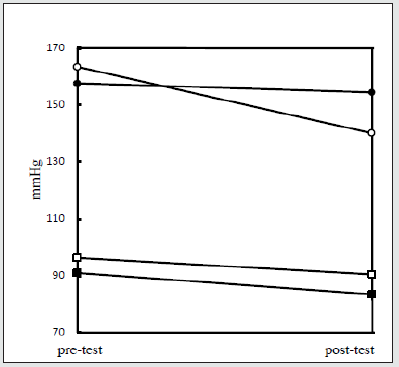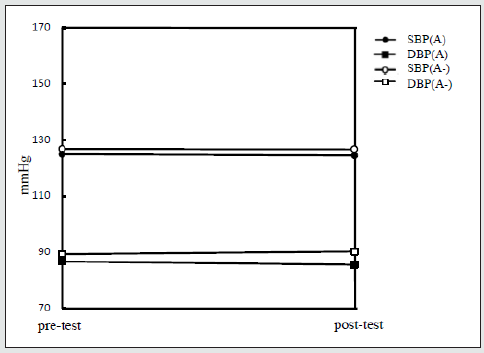
Lupine Publishers Group
Lupine Publishers
Menu
ISSN: 2644-1217
Research ArticleOpen Access
Calligraphic Handwriting Effects on Type A Personality of Hypertensive Patients Volume 3 - Issue 2
Henry S.R. Kao1*, Xintian Li2, Jinghan Wei2, Nianfeng Guo2, Jiatang Zhang2, Xiuqin Liu3, Cuiqin Yang3
1Department of Psychology, University of Hong Kong, Hong Kong
2Institute of Psychology, Chinese Academy of Sciences, Beijing
3Department of Neurology, Peking Union Medical College Hospital, Beijing
Received:June 25, 2021 Published: July 06, 2021
*Corresponding author: Henry S.R. Kao, Department of Psychology, University of Hong Kong, Hong Kong
DOI: 10.32474/OAJCAM.2021.03.000158
Background
Hypertension is one of the most common worldwide diseases afflicting humans. It is a serious condition that can lead to coronary heart disease, heart failure, stroke, kidney failure, and other health problems (National Institutes of Health, 2008). People who have hypertension can take steps to control it and reduce their risks for related health problems. Key steps include following a healthy lifestyle, having ongoing medical care, and following the treatment plan that the doctor prescribes. Most people who have hypertension will need lifelong treatment. Despite progress in prevention, treatment, and control of high blood pressure, hypertension remains a major public health challenge Whelton, et.al [1].
The etiology of hypertension is multifactorial, involving genetic factors, biophysiological processes, daily experiences throughout life. Some psychosocial factors, such as the Type A behavior pattern, anxiety, and depression, also play a significant role in the etiology of hypertension, which is supported by many epidemiological investigations Krantz, et.al.[2]; Markovitz, et.al.[3]; Spicer et.al. [4]. Yan et.al. [5] followed 3,308 adults with normal blood pressures, ages 18 to 30 years, for fifteen years for the development of high blood pressure. This study gives strong support to the role of psychological characteristics in the development of high blood pressure.
Chinese Calligraphic Handwriting (CCH) is a WHO Fancourt et.al. [6] recognized effective treatment. Its training can enhance the practitioner’s cognitive abilities, relax his bodily conditions, and stabilize his emotions. Its practice in general can also lead to serene, stable, comfortable, and quiet emotional states. These changes are indicated by the participant’s physiological changes. For example, their heart rate slows down, blood pressure decreases, and digital pulse volume also increases with corresponding reduction in EMG. In addition, greater control of breathing takes place during brush writing than do their normal resting breathing, etc. Kao et.al.[7].
Furthermore, long-term calligraphic practice can exert a subtle effect on one’s personality Kao et.al.[8]; Henry et.al.[9]. To examine the effects of calligraphic activities on the traits of human personality, we studied the relationship between CCH writing experience and traits of personality by the factors from the 16- Personality Factors (16 PF) was administrated to in practising adults and children. Results showed that CCH training can shape and change children and adults’ personality to a more mature state, including being more emotionally stable, conscientious, self-sufficient, controlled and with heightened learning ability. On basis of the above observations, we carried out an experiment to see if CCH training would be able to clinically treat hypertensive patients who were comorbid with both the trait of introversion and the traits of Type A personality. We expected that the CCH training would lead to significant reduction in the subjects’ blood pressure to be indexed by the Systolic and Diastolic blood pressures.
Method
Type A behaviour questionnaire is originated in the fifties, developed by Friedman et.al.[10] and was used for evaluating special types of behaviour of the patients with coronary heart disease. The Chinese version of the scale was revised by Zhang [11]. Type A personality refers to “a complex pattern of behaviors and emotions that includes an excessive emphasis on competition, aggression, impatience, and hostility.”.
It includes three dimensions: TH score indicates the sense of time rush, sense of tight timing and quick work etc.; CH score indicates competitive, strong desire to outshine others, having vigilance, hostility, and impatience etc. The classes of Type A behaviour are defined according to the total scores: Total score > 35 is Type A behaviour, scores between 28~34 is Type A-, score of 27 is the middle type, scores between 20~26 is type B-, and total score <19 is type B. Only when the subjects’ total scores were more than 27 would they be eligible to participate in the experiment. That is all the 20 participants were of Type A or Type A- personality. The experimental group of 10 patients practiced calligraphy for 30 minutes while the control group of 10 patients sat quietly for the same duration.
Results
Results showed that the post-writing decrease in blood pressure averaged 10.50 Hg. for the experimental group. The more salient decrease, averaged at 22 mmHg, was observed for the systolic blood pressure of the patients with Type A- personality. A significant post-writing reduction in systolic blood pressure was found (F=14.14; p<0.05) for the experimental group. While the post-writing reduction in systolic blood pressure was found for both the Type A and the Type A- patients, the drop in Type Apatients was significantly greater than in Type A patients (F=5.89; p<0.05). The patients in the control group showed no change in blood pressure between the two measurements.
Discussions
Results of the present study offer evidence for the therapeutic effects of brush handwriting on blood pressure reduction, particularly the systolic pressure, in patients with hypertension. Another significant finding is that after calligraphy handwriting, individuals with type A- behaviour showed greater reduction in systolic pressure than individuals with type A behaviour, which further disclosed the internal relationship among blood pressure, personality traits and calligraphic conduct. There can be two explanations for different blood pressure rectification effects of calligraphic conduct on individuals with type A- and type A personality. Firstly, type A individuals showed rather stable psychological tension elements and thus significant therapeutic effect would not occur only through once, or twice short-term calligraphic practice. That is, more calligraphy practice is needed for people with type A behaviors to achieve significant reduction in blood pressure. Secondly, type A- individuals, in terms of personality elements, include more non- type A personality features, or comprises with a certain proportion of type B personality features. Therefore, when conducting calligraphy, they are easier to relax nervous emotions, and regulate blood pressure. When conducting calligraphy, individuals can achieve a state like that generated by qigong and meditation-“entering into quietness”. They relax psychological tension, reduce body’s awakening level of the central nervous system, raise the activity level of non- central nervous system, regulate functions of internal organs, such as cardiovascular system etc., and finally, reduce heart rate and blood pressure. Hypertension has become such a common disease these days and psychological factors are playing an increasingly important role on the onset and course of hypertension. Calligraphy therapy, as an innovative, effective technique for emotion stability, stress reduction and general health improvement Kao, [12]; Goan [13]; Goan et.al.[14], can be applied widely to those suffering from psychosomatic diseases. In sum, short-term calligraphic practice seems to produce a more immediate effect on stable introverted individuals and type A- personality individuals than unstable extroverted or type A individuals.
References
- Whelton PK, He J, Appel LJ, Cutler JA, Havas S, et al. (2002) Primary prevention of hypertension: clinical and public health advisory from the National High Blood Pressure Education Program. JAMA, 288(15): 1882-1888.
- Krantz DS, DeQuattro V, Blackburn HW, Eaker E, Haynes S, et al. (1987). Psychosocial factors in hypertension. Circulation, 76: I84-I88.
- Markovitz JH, Matthews KA, Wing RR, Kuller LH, Meilahn EN et.al. (1991) Psychological, biological and health behavior predictors of blood pressure changes inmiddle-aged women. Journal of Hypertension, 99(5): 399-406.
- Spicer J, Chamberlain K (1996) Cynical, hostility, anger, and resting blood pressure. Journal of psychosomatic research, 40(4): 359-368.
- Yan LL, Liu K, Matthews KA, Daviglus ML, Ferguson TF, et.al. (2003). Psychosocial factors and risk of hypertension. Journal of the American Medical Association, 290(16): 2138-2148.
- Fancourt D, Finn S (2019) What is the evidence on the role of the arts in improving health and well-being? A scoping review. Health Evidence Network synthesis report 67.WHO-Europe, Copenhagen, Denmark.
- Kao HSR, Lam PW, Robinson L, Yen NS (1989). Psychophysiological Changes Associated with Chinese Calligraphy. In P. Plamondon, CU Suen, ML Simner (Eds.), Computer recognition and human production of handwriting. Singapore: World Scientific Publishing
- Kao HSR, Goan CH (1995) Calligraphy and the Personality of the Chinese intellectuals. In Chiao Chien & Pan Nai-ku. (Editors). Chinese Concepts and Behavious, Tianjin: Tianjin People's Press, pp. 311-324.
- Kao HS, R Min Xu and Tin Tin Kao (2021) Calligraphy, Psychology and the Confucian Literati Personality. Psychology and Developing Societies: March, N0. 33.
- Friedman M, Rosenman RH (1974) Type A Behavior pattern and your heart. New York: Knopf.
- Zhang BY (1985) Psychosomatic response characteristics of coronary heart disease patients. Acta Psychologica Sinica, 3(1985): 314-321.
- Kao HSR (Ed) (2000) Chinese Calligraphic Therapy. Hong Kong: Hong Kong University Press. pp. 489.
- Goan CH, Ng SH (2000) Chinese calligraphy and executive stress reduction. Paper for the 6th International Conference of Behavioural Medicine, Nov.15-18, Brisbane, Australia.
- Goan CH, Ng SH (2001) Calligraphy, personality, and executive stress. Submitted to the 2001Society of Behavioural Medicine Annual Meeting, March 21-24, Seatle, USA.

Top Editors
-

Mark E Smith
Bio chemistry
University of Texas Medical Branch, USA -

Lawrence A Presley
Department of Criminal Justice
Liberty University, USA -

Thomas W Miller
Department of Psychiatry
University of Kentucky, USA -

Gjumrakch Aliev
Department of Medicine
Gally International Biomedical Research & Consulting LLC, USA -

Christopher Bryant
Department of Urbanisation and Agricultural
Montreal university, USA -

Robert William Frare
Oral & Maxillofacial Pathology
New York University, USA -

Rudolph Modesto Navari
Gastroenterology and Hepatology
University of Alabama, UK -

Andrew Hague
Department of Medicine
Universities of Bradford, UK -

George Gregory Buttigieg
Maltese College of Obstetrics and Gynaecology, Europe -

Chen-Hsiung Yeh
Oncology
Circulogene Theranostics, England -
.png)
Emilio Bucio-Carrillo
Radiation Chemistry
National University of Mexico, USA -
.jpg)
Casey J Grenier
Analytical Chemistry
Wentworth Institute of Technology, USA -
Hany Atalah
Minimally Invasive Surgery
Mercer University school of Medicine, USA -

Abu-Hussein Muhamad
Pediatric Dentistry
University of Athens , Greece

The annual scholar awards from Lupine Publishers honor a selected number Read More...






